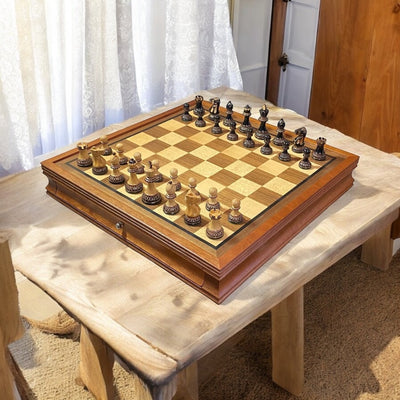Unlocking the Passion: Strategies for Teaching Kids to Love Chess
Chess is more than just a game; it's a world filled with strategy, critical thinking, and creativity. For many parents, introducing chess to their children can be a rewarding journey. However, getting kids to love chess can be a challenging task. Whether you are using an Isle of Lewis Chess Set or any other chess set, the key is to create an inviting environment that fosters their interest. In this article, we will explore various effective strategies that can help in teaching children to embrace the game of chess.
Understanding the Benefits of Chess for Children
Before diving into the strategies, it’s important to understand the myriad benefits that come with playing chess. Here are a few reasons why chess is an excellent choice for children:
- Enhances Critical Thinking: Chess fosters strategic thinking and problem-solving skills.
- Improves Academic Performance: Studies have shown that children who play chess often perform better in math and reading.
- Boosts Creativity: The game encourages imaginative thinking as players create strategies and visualize moves.
- Develops Patience and Discipline: Chess teaches children the importance of waiting, evaluating, and making calculated moves.
Creating an Inviting Chess Environment
The first step in nurturing a love for chess in children is to create an appealing environment. Here’s how to do it:
Choose the Right Chess Set
Using an aesthetically pleasing chess set can make a significant difference. The Isle of Lewis Chess Set, for example, is not only visually captivating but also historically rich. Having a set that captures their attention is a great starting point.
Design a Dedicated Chess Space
Set up a special area in your home for chess. This can be a small table with chess boards, a comfy chair, and even a chess clock. Create an environment that feels personal and exciting. You can include chess-themed decor, which can make the area enticing for kids and encourage regular play.
Make Learning Fun and Engaging
When it comes to teaching children anything, including chess, fun is always the best ingredient. Here are some suggested strategies:
Gamify the Learning Process
Incorporate games within the learning process. Use chess facts and puzzles as a part of the learning curve. You might even create small competitions and reward achievements. This can instill a sense of accomplishment and motivation to learn more.
Utilize Online Resources and Apps
There are numerous online platforms and apps designed specifically for teaching chess to children. Many of these resources combine games, lessons, and challenges that make chess enjoyable. You can allow your kids to practice online, where they can also engage with peers.
Break it Down: Teach the Basics First
It’s crucial to introduce the game step-by-step. Here’s how to effectively teach the fundamentals:
Introduce Each Piece Individually
Start with teaching the individual chess pieces, their movements, and their special abilities. This foundational knowledge will make playing the game more comprehensible. Explain the uniqueness of each piece and its value in strategy. You could use the Isle of Lewis Chess Set to showcase these movements interactively.
Play Simple Variations of the Game
To begin with, consider playing simplified versions of chess. Limiting the number of pieces on the board and allowing children to explore basic strategies can help ease them into the game. It simplifies the concept and makes it less overwhelming.
Encourage Regular Practice
Just like any skill, mastering chess requires practice. Here are some ways to help:
Organize Chess Playdates
Arrange regular chess playdates where your child can play with friends. Social interaction can enhance their excitement for the game. They can learn from each other and share new strategies, creating a vibrant chess-playing community.
Join a Local Chess Club
Finding a local chess club can work wonders for your child's chess journey. These clubs often provide opportunities to engage with other kids who share the same passion for chess. It encourages collaboration and healthy competition.
Make Learning About Chess Fun and Engaging
Creating an engaging learning experience extends beyond just playing the game. Here’s how to keep chess exciting for kids:
Incorporate Chess History into the Learning
Share captivating stories from chess history. For instance, talk about the Isle of Lewis Chess Set and its fascinating background. Famous matches and legendary players can pique their interest and add a layer of allure to the game.
Use Multimedia Resources
Incorporate books, documentaries, and videos that focus on chess tactics, famous games, and strategies. Engaging with content outside of actual gameplay can develop their understanding and appreciation of the game.
Inspire Through Example
Becoming a role model is one of the most effective strategies in teaching your child to love chess. Here’s how to inspire them:
Be Enthusiastic
Your passion for chess will be contagious! Show enthusiasm every time you play or talk about chess. Discuss strategies and victories, and celebrate wins together, even if they are just small achievements. The more positive energy you generate, the more likely they will want to participate.
Play Regularly with Them
Dedicate time to play chess with them consistently. Playing together not only improves their skills but also strengthens your bond. Use these moments as a chance to reinforce lessons, share tactics, and have fun. This also provides a relaxed way to introduce new skills and strategies.
Creating a Rewarding Experience
Make learning chess a rewarding experience that will encourage your child to invest in their skills:
Establish a Reward System
Develop a system where your child earns points or rewards for various chess-related accomplishments, such as completing a game, learning a new tactic, or attending a club meeting. This encourages perseverance and the continuous pursuit of knowledge.
Attend Tournaments Together
Participate in chess tournaments as a spectator or player. Watching skilled players can be inspiring, and your child may be motivated to replicate their moves and strategies. The excitement and environment of a tournament can create a lasting passion for the game.
Fostering a Chess Community
Encouraging your child to connect with other chess enthusiasts creates a sense of belonging. Here are a few tips to build that community:
Engage with Online Chess Forums
Online forums and platforms can provide your child with a space to connect with others who share their passion. Engaging in discussions about strategies, games, and experiences can enrich their understanding and appreciation of chess.
Create a Family Chess Night
Set aside a specific night each week for family chess. This special time fosters togetherness while deepening your child's interest in the game. Encourage every family member to participate, regardless of their skill level; this promotes a positive experience for everyone.
Are You Ready to Embrace the Chess Adventure?
Teaching kids to love chess isn’t just about mechanics; it’s about instilling passion and appreciation for a game rich in strategy and history. By creating an engaging, fun environment, fostering social connections, and leading by example, you can guide your child on a rewarding chess journey. Remember, the goal is not just to create a chess player, but a chess enthusiast. Embrace the adventure together, and who knows—it could lead to an enriching lifelong journey! So gear up with your Isle of Lewis Chess Set and let the chess games begin!









